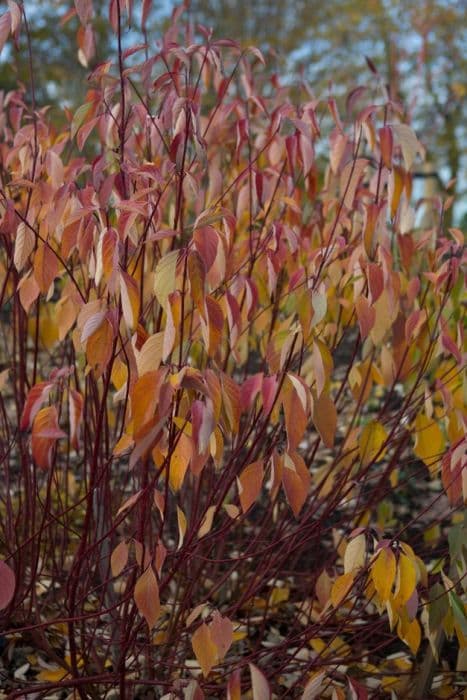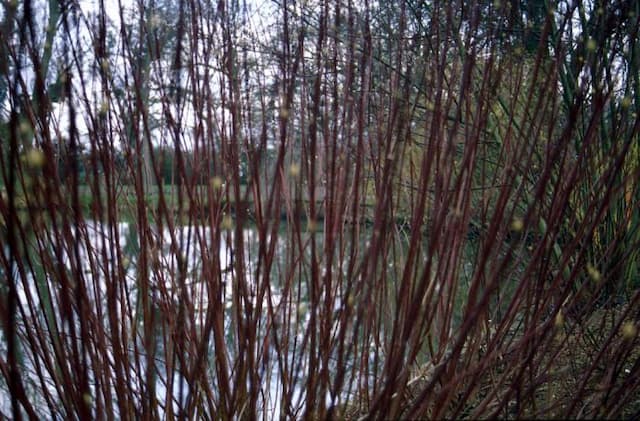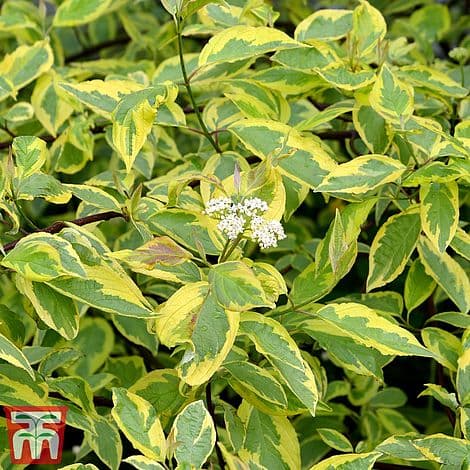Chinese dogwood Cornus kousa var. chinensis 'Claudia'











ABOUT
The 'Claudia' variety of Kousa dogwood is a visually captivating plant, known for its unique floral display and beautiful foliage. The main attraction is its star-like flowers, which are not actually true flowers but rather showy bracts that surround the plant's smaller, inconspicuous flowers. These bracts start out as a greenish-yellow and gradually mature to a creamy white color, offering a striking contrast against the foliage. The leaves of the Kousa dogwood 'Claudia' have an appealing shape, with pointed tips and gently wavy edges. They exhibit a vibrant green color that adds lushness to any garden setting. As the seasons change, so does the foliage, turning to a rich display of autumn colors that range from deep reds to purples and occasionally pink hues. Adding to its decorative appeal, 'Claudia' produces ornamental fruit that resembles a berry, starting out green and transitioning to a pinkish-red as they mature. These spherical fruits add an extra layer of interest to the plant in the late summer and into the fall, and they are also attractive to birds and wildlife. The branching structure of 'Claudia' is also visually pleasing, with a somewhat horizontal habit that contributes to its ornamental value. The bark is an attractive feature as well, with a mottled appearance that includes shades of gray and tan, providing winter interest long after the leaves have fallen. Taken together, these characteristics make the Kousa dogwood 'Claudia' a desirable plant for year-round aesthetic interest in the garden, offering a sequence of decorative changes from the spring bloom to the autumn foliage and winter bark texture.
About this plant
 Names
NamesFamily
Cornaceae
Synonyms
Chinese Dogwood, Kousa Dogwood, Korean Dogwood, Japanese Dogwood, East Asian Dogwood
Common names
Cornus kousa var. chinensis 'Claudia'.
 Toxicity
ToxicityTo humans
The Kousa dogwood is generally considered to be safe for humans. The fruit is even edible when ripe and is occasionally made into wine or jelly. However, unripe fruit and other plant parts might cause stomach upset if ingested. It's always advisable to be cautious and avoid eating any part of a plant unless you are certain about its edibility and have verified that it's safe to consume. There's no significant report of toxicity in humans associated with Kousa dogwood.
To pets
Kousa dogwood is generally recognized as non-toxic to pets such as dogs and cats. While it is always best to prevent pets from ingesting plants, there are no widely-recognized toxic effects associated with this particular dogwood variety. However, ingestion of any plant material may cause mild gastrointestinal upset for pets, such as vomiting or diarrhea, simply due to the introduction of non-typical food into their diet. If your pet consumes a large quantity of the plant and shows signs of distress, it is advisable to contact a veterinarian.
 Characteristics
CharacteristicsLife cycle
Perennials
Foliage type
Deciduous
Color of leaves
Green
Flower color
White
Height
15-20 feet (4.5-6 meters)
Spread
15-20 feet (4.5-6 meters)
Plant type
Tree
Hardiness zones
5-8
Native area
China
Benefits
 General Benefits
General Benefits- Ornamental Value: Cornus kousa 'Claudia' has an attractive floral display with star-like blooms in spring, enhancing garden aesthetics.
- Seasonal Interest: This cultivar offers multi-season interest with flowers in spring, berry-like fruit in summer, and vibrant foliage in the fall.
- Drought Tolerance: Once established, it has a good tolerance for drought, reducing the need for frequent watering.
- Pest Resistance: 'Claudia' is resistant to many of the pests that commonly afflict other dogwoods, helping to keep the plant healthy with less maintenance.
- Disease Resistance: It shows resistance to dogwood anthracnose and powdery mildew, which can be serious problems for other Cornus species.
- Wildlife Attraction: The fruit produced can attract birds and other wildlife to the garden, providing a natural environment and potential for wildlife viewing.
- Compact Size: This variety tends to be smaller and more compact, making it suitable for gardens with limited space.
 Medical Properties
Medical Properties- Anti-inflammatory: The fruit of Cornus kousa has been reported to have anti-inflammatory properties.
- Antioxidant: The plant contains compounds that exhibit antioxidant activities, offering potential protection against oxidative stress.
- Antimicrobial: Extracts from the plant may have antimicrobial effects against certain bacteria and fungi.
- Anticancer: There is some preliminary evidence to suggest that the compounds in Cornus kousa might have anticancer properties.
 Air-purifying Qualities
Air-purifying QualitiesThis plant is not specifically known for air purifying qualities.
 Other Uses
Other Uses- The fruit of the Kousa Dogwood can be used to make wine or jelly due to its unique sweetness once fully ripe, offering a culinary use distinct from its ornamental value.
- Its wood is hard and dense, which makes it suitable for making high-quality handcrafted items such as tool handles or small woodworking projects.
- The inner bark can be used as a component in creating natural dyes, providing soft shades of color for textile projects.
- Kousa Dogwood fruit can be used in baking, much like berries, by adding them to muffins or pancakes for a tropical flavor twist.
- The leaves, when dried, can be incorporated into potpourri mixes to contribute a gentle woodland scent to a room.
- Pressed and dried flowers from the Kousa Dogwood make beautiful additions to art projects like botanical prints or homemade paper.
- Branches and twigs can be used in floral arrangements or wreaths, especially due to their interesting shapes and textures.
- When in bloom, the tree can serve as a living seasonal decoration in landscaping, offering an alternative to cut flowers.
- Fallen leaves can be collected and used as mulch, which then decomposes and contributes to soil fertility.
- The tree's stature and branching pattern is ideal for bonsai cultivation, adding aesthetic value in miniature gardens.
Interesting Facts
 Feng Shui
Feng ShuiThe Kousa dogwood is not used in Feng Shui practice.
 Zodiac Sign Compitability
Zodiac Sign CompitabilityThe Kousa dogwood is not used in astrology practice.
 Plant Symbolism
Plant Symbolism- Regeneration: In various cultural beliefs, Cornus kousa is seen as a symbol of renewal and regeneration because it sheds its flowers and leaves and regrows them anew each year.
- Purity: The white flowers of the Kousa dogwood often symbolize purity and innocence due to their delicate and clean appearance.
- Christian Symbolism: The dogwood, related to the variety Cornus kousa var. chinensis 'Claudia', is often associated with Christianity. It is believed that the dogwood was once large and strong until it was used to make the cross on which Jesus was crucified. The flowers represent the cross— with two long and two short petals.
- Endurance: Kousa dogwood is known for its hardiness and its ability to withstand various conditions, symbolizing endurance and the ability to withstand adversity.
- Love & Affection: In some traditions, the dogwood flowers represent the bonds of love and are given as tokens of affection due to their heart-shaped petals.
 Water
WaterThe Chinese Dogwood 'Claudia' should be watered deeply once a week during its growing season, providing approximately 1.5-2 gallons each time to ensure that the water reaches the root zone. Adjust the amount during periods of rainfall, reducing supplemental watering accordingly. During the dormant season, you can reduce the frequency of watering, monitoring the soil moisture and only watering when the top 2 inches of soil become dry. Overwatering can cause root rot, so ensure proper drainage and do not let the plant sit in soggy soil.
 Light
LightThe Chinese Dogwood 'Claudia' thrives in a location with full sun to partial shade. The best spot provides morning sunlight and afternoon shade, especially in areas with hot summers, to prevent leaf scorch. Consistent light conditions promote the best flowering and berry production, as well as a vibrant fall color display.
 Temperature
TemperatureThe Chinese Dogwood 'Claudia' prefers a temperature range between 60°F and 75°F for optimal growth. It can withstand minimum winter temperatures down to about -10°F and summer highs up to 90°F without major stress. Ensure the plant has good air circulation to prevent diseases that can be exacerbated by extreme temperature fluctuations.
 Pruning
PruningPruning the Chinese Dogwood 'Claudia' is primarily to maintain its shape and remove any damaged or diseased wood. It is best done in late winter or early spring before new growth starts. Thin out older stems to encourage airflow and light penetration, which is crucial for the health and blooming of the plant. Pruning is not typically required frequently, once every two or three years is often sufficient for young trees, while mature specimens may need annual light pruning.
 Cleaning
CleaningAs needed
 Soil
SoilThe Kousa Dogwood 'Claudia' prefers a well-draining, fertile soil with a slightly acidic pH between 5.5 and 6.5. An ideal soil mix can be made by combining loam, compost or well-rotted manure, and a bit of sand to improve drainage.
 Repotting
RepottingKousa Dogwood 'Claudia' trees do not often require repotting as they are usually planted outdoors. In a pot, young trees can be repotted every 2-3 years, stepping up the pot size gradually until it is planted in the ground.
 Humidity & Misting
Humidity & MistingThe Kousa Dogwood 'Claudia' thrives in moderate humidity levels typically found in outdoor environments and does not require specific humidity adjustments.
 Suitable locations
Suitable locationsIndoor
Give Kousa Dogwood 'Claudia' bright light, limited space.
Outdoor
Plant in partial shade, ensure moist, well-drained soil.
Hardiness zone
5-8 USDA
 Life cycle
Life cycleCornus kousa var. chinensis 'Claudia', commonly known as the Chinese dogwood 'Claudia', begins its life as a seed, which after stratification, germinates in the spring. The seedling grows into a juvenile plant and eventually develops into a mature shrub, with distinctive layered branching patterns. Flowering typically occurs in late spring to early summer, when the tree produces white, star-shaped bracts surrounding small, inconspicuous flowers. After pollination, the flowers develop into berry-like fruits called drupes that mature in late summer to fall and are appreciated by birds. The tree experiences annual cycles of growth, flowering, and fruiting, with leaf fall occurring in autumn followed by winter dormancy. Over several years, the plant may reach its full height of 15-30 feet, and can live for numerous decades, completing its life cycle upon senescence and eventual death.
 Propogation
PropogationPropogation time
Spring to early summer
The Chinese dogwood 'Claudia' is most effectively propagated through softwood cuttings taken in late spring to early summer. This method involves selecting a healthy, non-flowering stem of the current year's growth. The cutting should be about 4-6 inches (10-15 cm) long, with the lower leaves removed. The cut end is then dipped in rooting hormone to encourage root development and planted in a well-draining soil mix. After planting, the environment should be kept humid, often by covering the cutting with a plastic bag or using a misting system, and the soil should be consistently moist but not waterlogged. The cuttings typically root in several weeks, after which they can be gradually acclimatized to less humid conditions before potting on or planting out.









